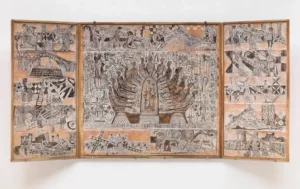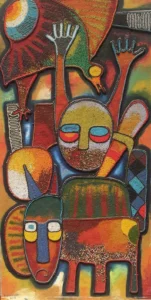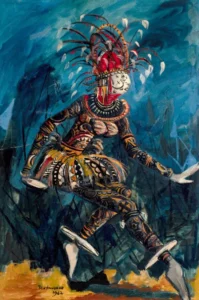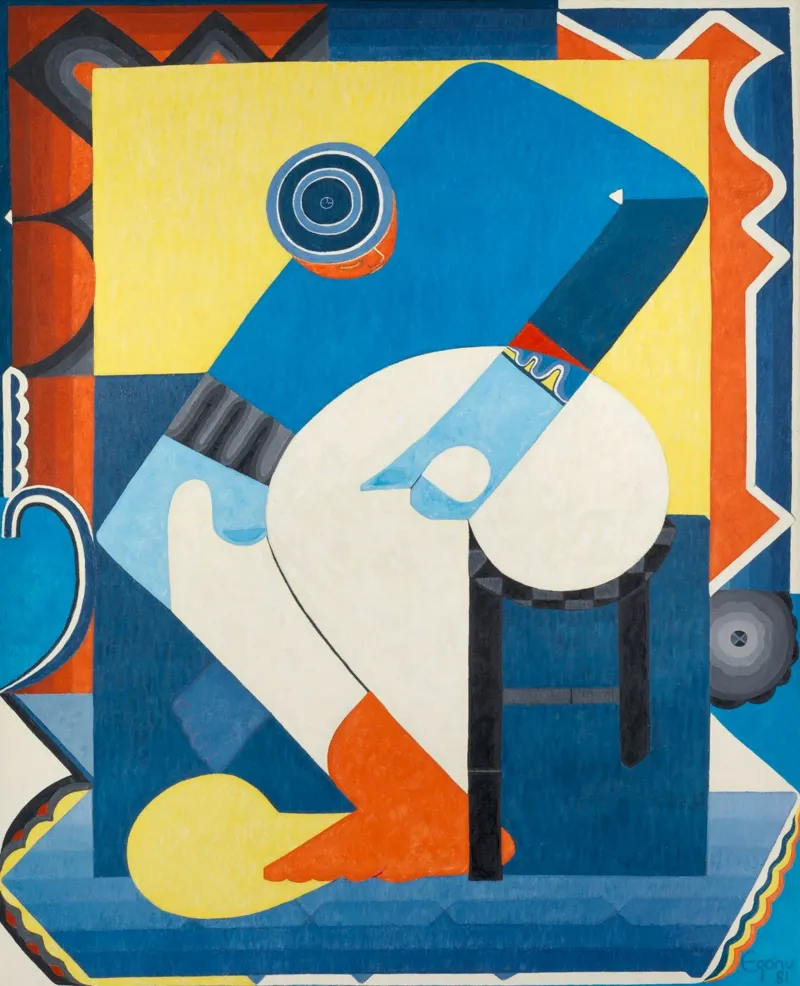A Historic Global Moment
London’s Tate Modern has unveiled Nigerian Modernism (8 October 2025 – 10 May 2026), the first UK exhibition fully dedicated to modern Nigerian art. It spans five decades and more than 50 artists, showcasing how Nigerian creators built a visual language rooted in both African tradition and global modernism.
Featuring celebrated figures like Ben Enwonwu, Uche Okeke, Ladi Kwali, Demas Nwoko, and Bruce Onobrakpeya, alongside movements such as the Zaria Art Society and the Oshogbo School, the exhibition reframes Nigerian art as a major force in world culture. It tells a story of independence, experimentation, and resilience — proof that Nigerian artists were not passive imitators but pioneers who redefined modernism through African eyes.
This recognition by one of the world’s most influential museums is not merely cultural—it’s political, economic, and deeply national. It restores Nigerian modernism to its rightful place in global art history and positions Nigeria as a hub of creative excellence.

Why This Matters
In the 1950s and 60s, Nigerian artists like Okeke championed “Natural Synthesis” — blending Western art education with indigenous symbols and philosophies. They believed that true modern Nigerian art must emerge from native roots, not colonial mimicry. Tate Modern’s exhibition now validates that belief on the world stage.
For decades, Western art history relegated Africa to anthropology rather than artistry. Nigerian Modernism corrects that distortion. It proves that modern art is not European property but a shared, human story — and that Nigeria’s voice in that story is indispensable.
Global Context and Comparative Lessons
Other nations have walked this path. When Mexico, India, and Brazil received similar museum spotlights, the effects were transformative. Their artists gained international markets, universities developed new curricula, and cultural exports became sources of national income and pride.
Nigeria’s moment at Tate Modern could yield similar dividends. As collectors, critics, and curators converge in London for Frieze Week, the world’s art market and media will turn their attention to Nigerian creativity — likely sparking exhibitions, academic studies, and investments for years to come.

The Wider Benefits for Nigeria
1. Economic and Creative Growth
Nigeria’s creative industries already contribute roughly ₦1.97 trillion (≈$1.4 billion) to GDP. Nollywood produces about 2,500 films annually and employs millions. Visual art, design, and crafts can become the next frontier — with potential for tourism, exports, and cultural entrepreneurship.
2. Soft Power and Global Image
This exhibition amplifies Nigeria’s rising global image built through:
Music: Afrobeats dominating international charts (Rema’s Calm Down is one of the most streamed songs in history).
Sports: Tobi Amusan’s world-record victory and perseverance under scrutiny.
Industry: The Dangote Refinery demonstrating large-scale national competence.
Now, Art joins the narrative — completing a powerful story of Nigerian excellence in multiple sectors.
3. Youth Engagement and Opportunity
Nigeria’s youth population—over 60% under age 25—is brimming with untapped creativity. Many lack access to structured art education or exposure to creative careers. A national focus on the arts could engage millions of young Nigerians, helping them discover and develop talents that might otherwise remain hidden.

By opening creative pathways, Nigeria can transform potential unemployment into innovation. Every paintbrush, camera, clay pot, or digital tablet becomes an instrument of nation-building.
Educational Imperatives
Currently, Nigeria’s new curriculum places art under humanities, reducing its visibility. This undervalues the arts and limits their capacity to shape creative, critical thinkers. If the nation wants to benefit from global recognition, art must be restored to the centre of education.
Key actions:
1. Reinstate Art as a Core Discipline – Create a Creative and Cultural Industries (CCI) pathway from junior secondary through tertiary level. Make visual art, design, music, and film integral subjects, not electives.
2. Upgrade School Facilities – Convert idle classrooms into art studios with pottery wheels, digital drawing tablets, and printing presses.
3. Train Teachers and Mentors – Establish Artist-in-Residence programs where professionals teach in schools each term. Provide short training courses for 500 art teachers yearly.
4. Support Young Talent – Launch a National Youth Arts Corps to deploy art graduates into public schools and cultural centres. Fund student art fairs to build entrepreneurship and confidence.
5. Leverage Technology – Digitize Nigeria’s art archives and develop online museum tours and workshops for remote learners.
6. Scholarships and Private-Sector Partnership – Build on corporate sponsors of the Tate exhibition, such as Access Holdings and Coronation Group, to endow art scholarships, creative incubators, and overseas fellowships.

Infrastructure and Sustainability
Recognition abroad must translate into structures at home.
Digital Archive: Create a Nigerian Modernism online repository of artworks, essays, and oral histories to preserve national heritage.
Regional Cultural Hubs: Upgrade cultural centres in Lagos, Abuja, Enugu, Ibadan, Benin, and Kaduna to international exhibition standards.
Travelling Exhibitions: Organize shows across Africa, Europe, and North America to maintain visibility after the Tate exhibition ends.
These initiatives would build institutional memory, attract tourism, and position Nigerian art as a continuous global conversation.
For Schools: A Practical One-Year Plan
Term 1: Introduce the story of the Zaria Art Society and “Natural Synthesis.” Use motifs from uli and adire traditions for practical exercises.
Term 2: Focus on sculpture, printmaking, and design inspired by Onobrakpeya and Nwoko. Students curate mini exhibitions or murals.
Term 3: Host a School Art Fair, where works are priced, displayed, and marketed to the community. Invite local collectors, banks, and media to bridge art and enterprise.
This plan connects culture to livelihood — turning creativity into competence.
Metrics of Success
Students: Every secondary-school student builds a personal art portfolio before graduation.
Teachers: 500 trained annually in creative teaching and digital art.
Infrastructure: Six state cultural centres upgraded within three years.
Economy: Ten new galleries or creative businesses launched yearly; local artists represented in major global fairs.
When measured in skills, jobs, and pride, art becomes not an expense but an investment.
Why Authorities Must Act
Tate Modern’s recognition offers Nigeria a brief but powerful window to convert global attention into national development. This is not charity from abroad—it’s evidence of value already created by Nigerian minds and hands.
If the government, education boards, and private sector align, the outcome could be a creative revolution rivaling the tech and entertainment booms. Art education breeds discipline, design thinking, and innovation — qualities every growing economy needs.
For policymakers, the message is clear: Art is not ornamental. It’s strategic.
It drives tourism, employment, national branding, and youth engagement. Countries that invest in creative education—like South Korea, India, and Brazil—harvest the benefits through innovation and global influence.

The National Patriots.
Conclusion
Nigerian Modernism at Tate Modern is far more than an art exhibition. It is an invitation — for Nigeria to see itself through a new lens. It proves that Nigerian art can stand proudly on the world stage and that, with the right support, it can become a major export of culture, intellect, and pride.
This moment should ignite a long-term national commitment to creativity, youth empowerment, and educational reform. When a young student in Kano or Calabar realizes their art could hang in the Tate Modern one day, hope and purpose are reborn.
Nigeria has always been rich in talent. What it needs now is the structure, policy, and belief to let that talent shine.
If we act wisely, this could be the beginning of a new Nigerian renaissance—where art becomes both the mirror and the engine of national progress.
Dr. G. Fraser. MFR
The National Patriots.
Headlinenews.news Special report.




